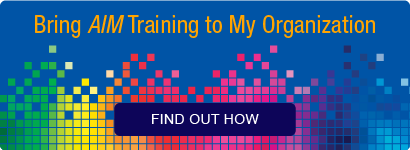One of the challenges in change management training is balancing the needs of the organization with the needs of associates. On the one hand, the organization needs to move as quickly as possible to implement the elements of its competitive strategy, whether that includes new technology, new business processes, a changed culture, and/or a new structure. 
But on the other hand, the reality is that the organization can only move as quickly to full implementation as each Target changes his or her behavior. Organizational change occurs both individually, and collectively.
Your organization's associates may know rationally that organizational change is a business imperative, and the stream of changes isn't going to stop. Yet, there's resistance to change. It's an inevitable tension point that must be managed.
This is even more challenging in a world where the frenetic and unabated pace of change can be a huge source of personal stress, anxiety, and pain.
Those individuals who can self-manage productively through this tension are usually perceived to be "successful." There are enormous payoffs for the person, and the organization when individuals can change productively!
Change is a group event, but an individual experience. This means that:
1. Change readiness varies from person to person.
2. Perceptions of change vary from person to person.
3. Sources of resistance to change vary from person to person.
4. Reactions to change are situational, and go across a continuum from slow adapters to fast adapters.
5. Not everyone will react the same way to events.
In a sense, change functions much the way gravity does. The status quo is always pulling Targets back to the old ways.
Therefore, there has to be a motivational shift that encourages associates to leave the present state and move to the unknown future. This motivation can come from opportunity, need, discomfort, or pain. The motivational shift must be accompanied by a change in reinforcement. Your "current state" exists because people are reinforced, knowingly or unknowingly, to maintain what is now the status quo.
One thing organizations can do is to prepare people for what to expect when it comes to dealing with change. The dynamics of change are quite predictable. That's why change management training programs like IMA's ChangePro can be such a useful addition to the readiness plans for complex or transformational change. Not as a stand-alone program, but as part of a larger change readiness plan!
For example, the ChangePro change management training program has three objectives:
1. To let associates know in advance what is likely to occur, so that they can avoid excessive change-related emotions that can lead to resistance or slow down the change.
2. To make associates aware of the emotional patterns that they and their colleagues are likely to experience.
3. To equip associates with a proven set of behaviors and tactics that they can apply and that is customized to that individual's particular needs. It's not a one-size-fits-all solution because work situations, past experiences, personal strengths/weaknesses, and the nature of a specific project can all influence reactions.
It's quite true that there are no simplistic answers or ways to cope with the barrage of changes confronting individuals today. While organizations can't necessarily eliminate "change fatigue," it is true that providing individuals with a sense of control over their environment has substantial pay-off for both the person and the organization.
Organizations will benefit when associates are prepared to handle changes productively, in a professional manner. That's the personal experience of change, and that's how the change occurs organizationally-- one individual at a time.


